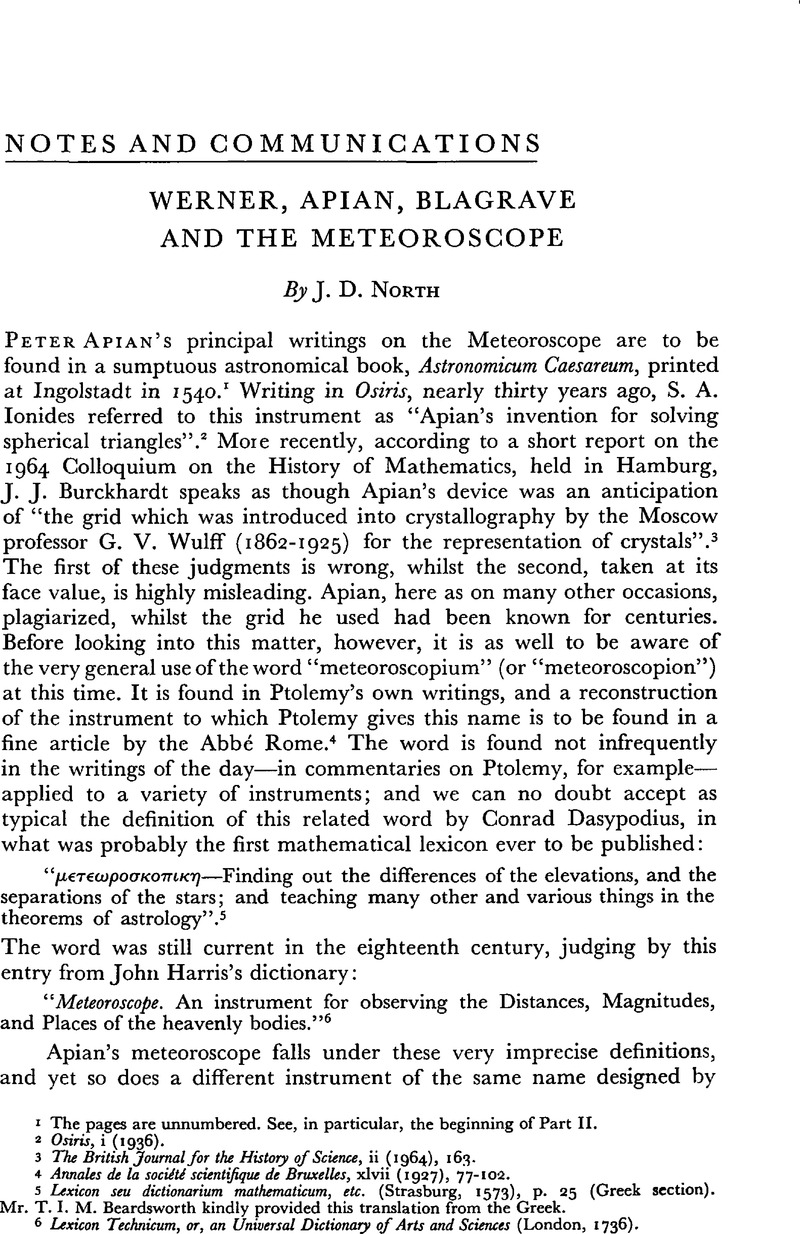Article contents
Werner, Apian, Blagrave and the Meteoroscope
Published online by Cambridge University Press: 05 January 2009
Abstract

- Type
- Notes and Communications
- Information
- Copyright
- Copyright © British Society for the History of Science 1966
References
1 The pages are unnumbered. See, in particular, the beginning of Part II.
2 Osiris, i (1936).Google Scholar
3 The British Journal for the History of Science, ii (1964), 163.Google Scholar
4 Annales de la société scientifique de Bruxelles, xlvii (1927), 77–102.Google Scholar
5 Lexicon seu dictionarium mathematicum, etc. (Strasburg, 1573), p. 25Google Scholar (Greek section). Mr. T. I. M. Beardsworth kindly provided this translation from the Greek.
6 Lexicon Technicum, or, an Universal Dictionary of Arts and Sciences (London, 1736).Google Scholar
7 Mentioned again below. Some confusion exists over this work, as the result of its opening sentence: “Organum Ptolemaei Reverendissime domine…” It does not contain a treatment of any of the instruments which were known under the generic name organum Ptolemei. These instruments derive ultimately from Ptolemy's Analemma (translated as Liber de annalemmate by William of Moerbeke). They include the navicula-type sundial (“little ship of Venice”). The same projection appears to have been revived by Regiomontanus for the sundial known by his name (universal rectilinear altitude dial). Three different texts, all roughly contemporary with Regiomontanus, and dealing with the Organum Ptolomei, are to be found in the Vienna Hofbibliothek, Latin MSS. 5258 (ff. 80r-81v, with figure), 5303 (ff. 253v-255v, with figure), 5418 (ff. 180r-189v, virtually the same text); and Munich Stadbibliothek, Latin MS. 24105 (ff. 85r-88r, Canones Magistri Andree Stiborii Boi…, no figure). Another text, probably related, is Bibliothèque Nationale, Latin MS. 5789 (ff. 215r-216v). So far as I know, nothing has been written on the manuscript tradition of this important projection. (There are four MSS. in Oxford, of a much earlier date, dealing with the navicula, and another in the British Museum.)
8 Mr. Francis Maddison has provided the following historical notes on the universal astrolabe projection: ‘Alî b. Khalaf (Toledo, 11th C.) was probably the inventor of the Lamina universal, described in the Libros del saber, c. 1277. Az-Zarqellu (Toledo, 11th C.) improved and simplified the Lamina universal and wrote a treatise on it. This is the type of universal astrolabe which goes by his name. Several maghribí Islamic instruments of a later date bear the same projection. Az-Zarqellu's astrolabe was known in medieval Christian Europe, where it was called the saphea arzachelis or simply saphea. Rare examples survive, and are to be seen in museums in Oxford and Cracow. Gemma Frisius describes a similar astrolabe as his astrolabum (sic) catholicum in his book De astrolabo catholico, published in 1550. (This is referred to again below.) On Az-Zarqellu, see Vallicrosa, J. M. Millás, Estudios Sobre Azarquiel (Madrid-Granada, 1943–1950), ch. 9, pp. 425–455.Google Scholar On Gemma's astrolabe, see Michel, Henri, Traité de l'astrolabe (Brussels, 1947).Google Scholar
9 Taking the Vienna MSS., they are as follows (with incipits in brackets): Latin MS. 5311, ff. 34v-35r (Descripcionum que sunt in facie tabule…). This is a translation of Part II of Az-Arqellu's treatise. Latin MSS. 5496, ff. 58v-66r, 5258, ff. 55v-61r (Saphea et spera proiecta in plano cuius circuii…). The former copy is not listed by Thorndike and Kibre, while I imagine that their 5255 is a misprint for 5258. Latin MS. 5258, ff. 65v-71v (In zaphea precedenti circuii qui paralleli nuncupati sunt…). Supplementary to the foregoing: Latin MS. 5258, ff. 88v-89r (Ex saphea orizontale horologium in quocumque elevationum fabricare). Stiborius's canons. Cf. another Stiborius text in Munich Stadtbibliothek: Latin MS. 24105, ff. 69r-85r (Saphea est instrumentum universale…). See footnote 7 above.
10 These, which were published in 1524 and 1534, begin: “Locum Sous uerum in dorso per diem…” and “Saphea iam pridem uocato creditur siue quasi sphera…”
11 At Nuremberg. Notice also his Tractatus super propositions Ptolemaei de sinubus et chordis (Nuremberg, 1541).
12 De lateribus et angulis triangulorum (Wittenberg, 1542). This comprises the trigonometric part of the De revolutionibus of 1543. Rheticus supervised its publication.
13 There is no such possibility in plane trigonometry, of course.
14 “We see how hated is mathematics, on account of its apparent difficulty. We have tried to simplify it, and have worked out new ways in which we may help those who are perplexed by arithmetic.” (From the introduction to the Astronomicum Caesareum.)
15 The MSS. were published in Abhandlungen zur Geschichte der Mathematischen Wissenschaften, xxiv, Part i (1907) and Part ii (1913)Google Scholar. The historical notes by Björnbo, which are to be found in the first part, are very valuable.
16 The letter to Bessarion was reprinted as a chapter of Annuli astronomici, by Petrus Beausardus (Paris, 1558). It is not in the 1553 (Antwerp) edition of this work.
17 No such work is listed by F. van Ortroy, Apian's bibliographer. See Bibliographie de l'oeuvre de Pierre Apian (reprinted Amsterdam, 1963). The title of the book by Gemma does not, on the other hand, go on to mention the meteoroscope.
18 Apian's Instrumentum sinuum of 1541 gives tables of sines to five figures. Purbach's book, of the same year, gave tables to seven figures.
19 An example of this instrument, probably by Thomas Gemini, is now in the collection at the Adler Planetarium, Chicago. See Gunther's, Astrolabes of the World, vol. ii, pp. 492–501Google Scholar, which includes illustrations from Blagrave's book.
20 Conclusion to the Meteoroscope section of the Astronomicum Caesareum.
21 So, indeed, did one of Werner's meteoroscopes.
22 P. 39.
- 1
- Cited by


